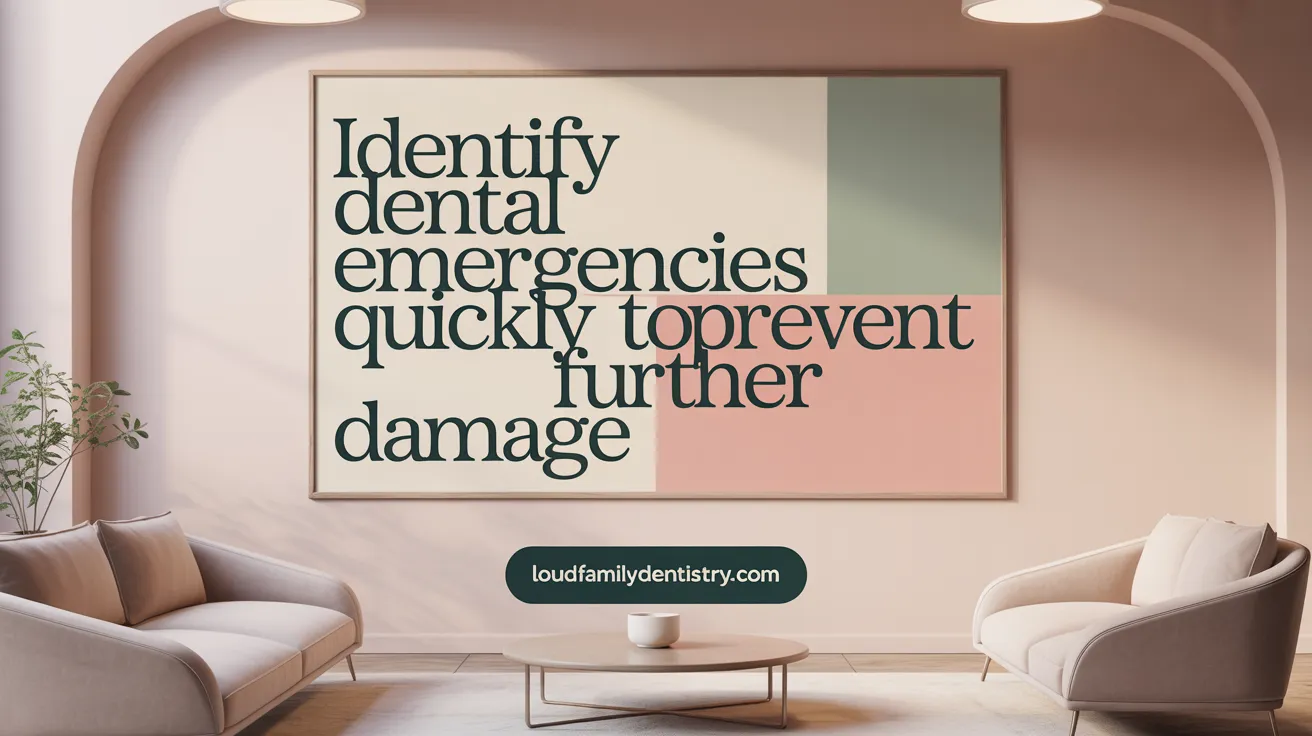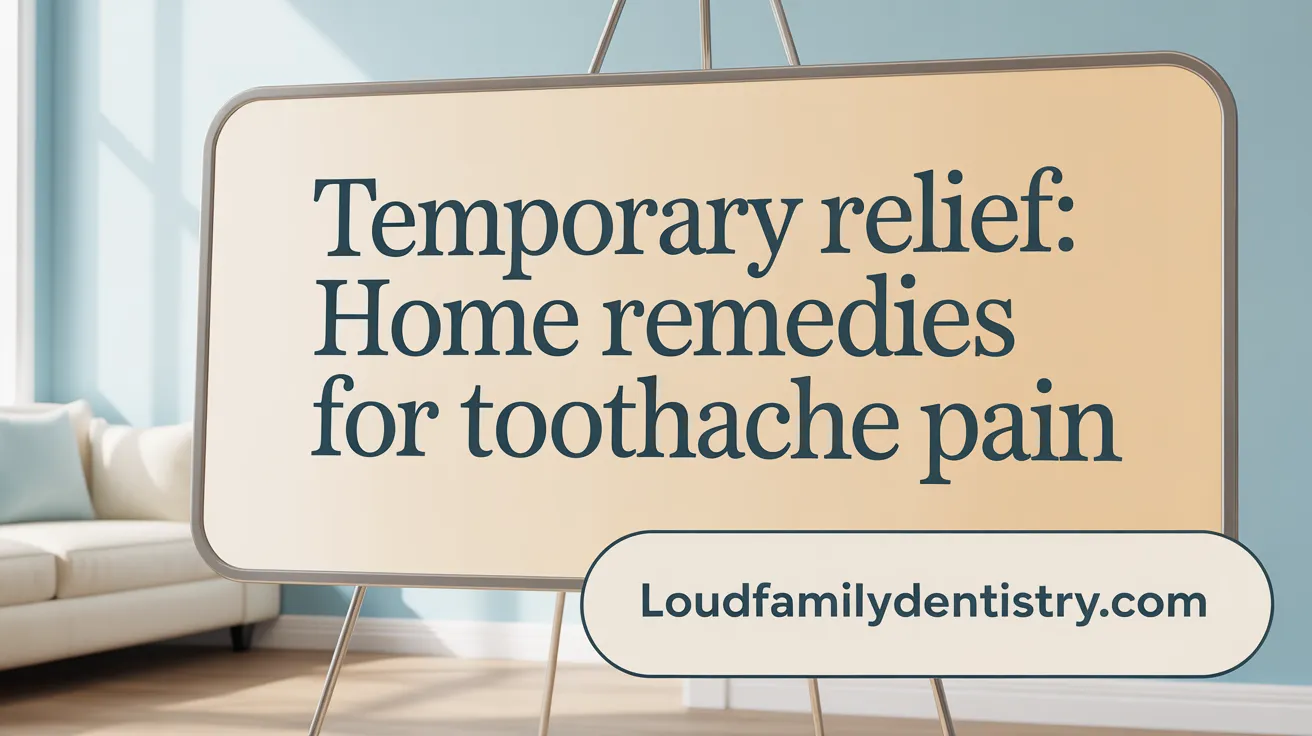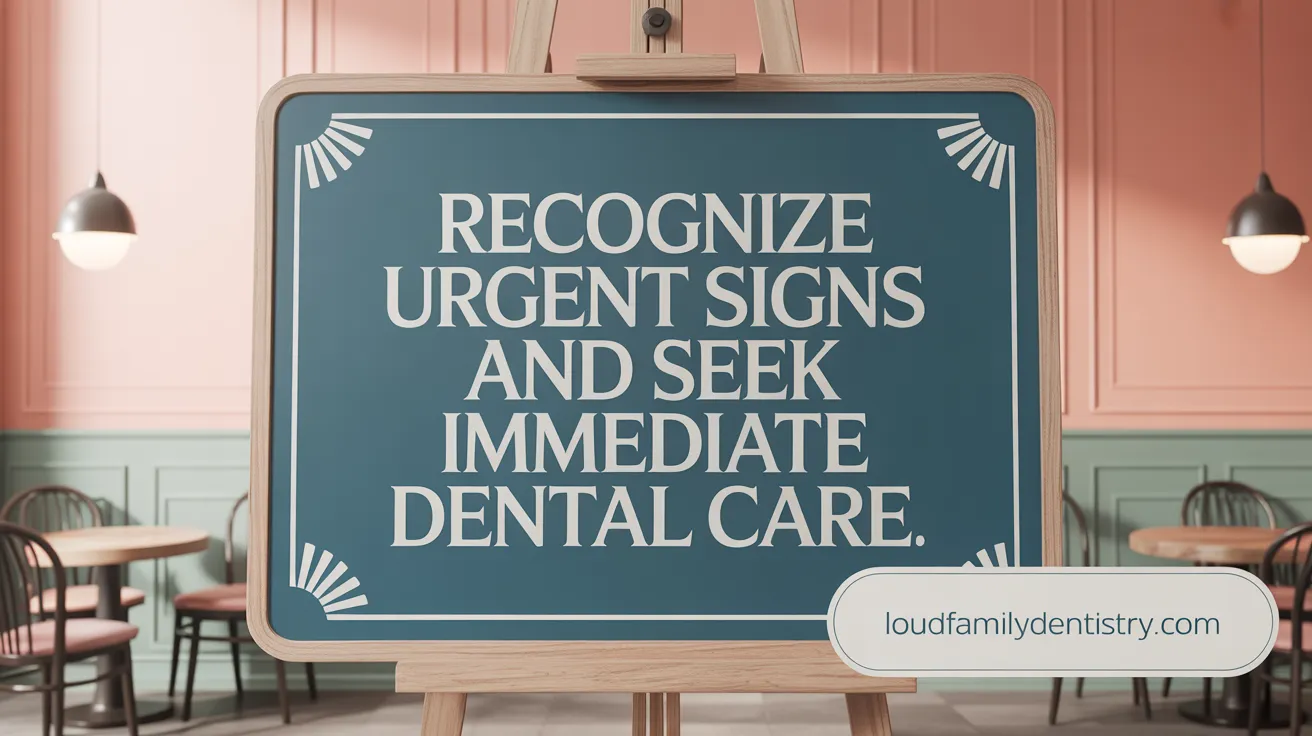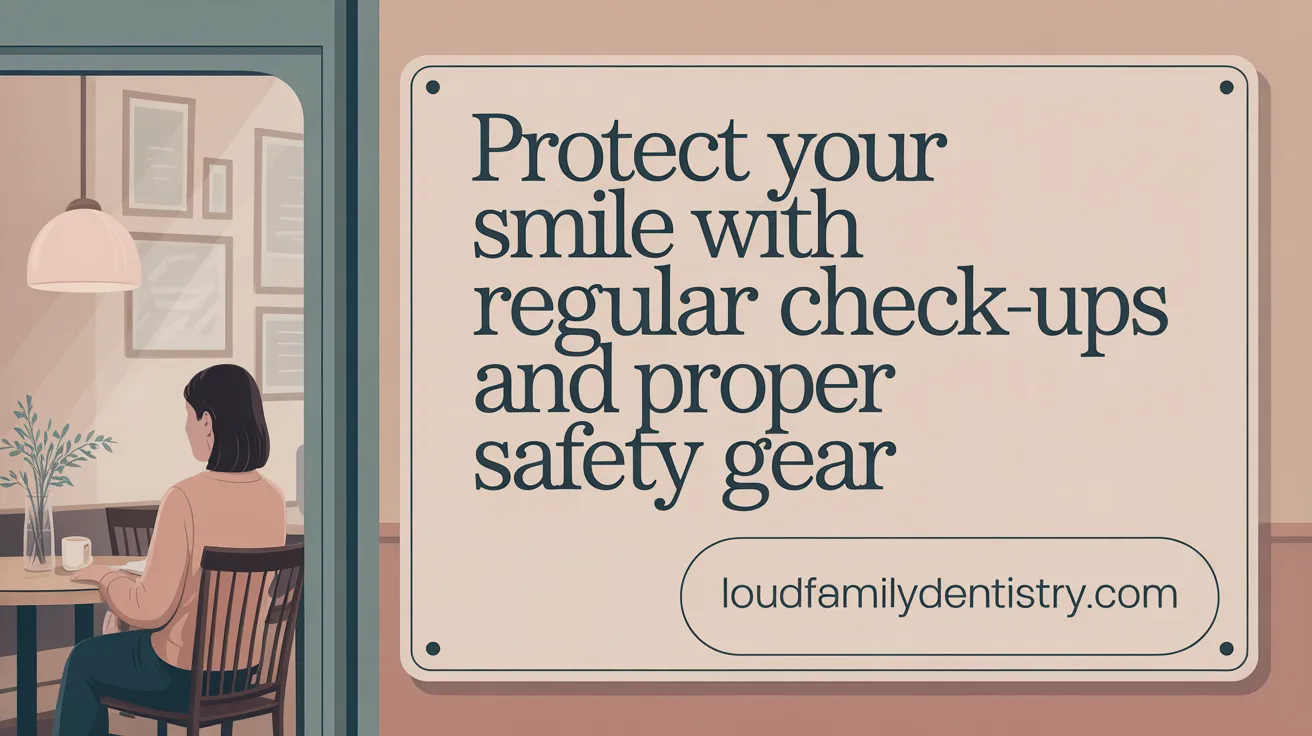Understanding and Managing Dental Pain in Emergencies
Dental pain can strike unexpectedly and with intense severity, especially when awaiting emergency dental treatment. Proper management of pain not only provides relief but also helps prevent further complications before definitive care. This article explores effective home remedies, practical steps, and important precautions for managing dental pain while you prepare for or wait on emergency dental treatment, ensuring comfort and reducing risks in urgent oral health situations.
Recognizing When Immediate Dental Care is Needed

What Constitutes a Dental Emergency Requiring Immediate Care?
Dental emergencies include conditions that need prompt professional attention to prevent further damage or complications. These emergencies cover severe toothaches that don't improve with medication, knocked-out or badly cracked teeth, uncontrolled bleeding, dental abscesses (infections causing swelling and pus), and serious injuries to the soft tissues of the mouth. For detailed information, see What is a dental emergency.
Common symptoms signaling a dental emergency are intense pain, swelling of the face or gums, persistent bleeding that won't stop, and trouble swallowing or breathing. These signs indicate that immediate dental care is essential. Learn more about Signs of dental emergency.
When Should a Patient Seek Emergency Dental Care Versus Visiting an Emergency Room?
For most dental issues such as toothaches, broken teeth, or lost fillings, contacting an emergency dentist is the best option. Emergency dental offices have the specialized equipment and expertise required for definitive treatments like reimplanting teeth or managing infections. See Emergency dentist at Glenhaven Dentistry and Emergency dental care.
Emergency rooms (ERs) play a role mainly when there are severe facial injuries, fractures, or if no dental care is accessible. ERs can provide temporary pain relief and antibiotics but usually lack the tools to perform dental procedures, making their care limited and often more costly. More info at Visiting the ER for dental emergencies.
Common Dental Emergencies and Their Symptoms
- Severe Toothache: Continuous, throbbing pain that disrupts daily activities. See Managing severe toothache.
- Knocked-Out Tooth: Tooth completely dislodged from the socket, requiring fast action. Refer to Knocked-out tooth care and Tooth reimplantation.
- Broken or Cracked Tooth: Visible damage often with pain and possible bleeding. See Treatment for cracked or broken tooth.
- Dental Abscess: Swollen, red area with pus, often accompanied by fever. Learn more at Dental abscess care.
- Uncontrolled Bleeding: Continuous bleeding following injury or dental procedures. Guidance available at Emergency dental first aid steps.
Recognizing these conditions early and seeking prompt professional care can prevent complications such as infection spread, tooth loss, or lasting damage. For step-by-step advice, see Dental emergency immediate action.
Immediate First Aid Measures to Manage Dental Pain
What immediate steps can help reduce pain and swelling?
Gently rinsing the mouth with warm salt water is a simple yet effective way to cleanse the area around the tooth and reduce inflammation. Use about half a teaspoon of salt dissolved in a glass of warm water, swish for 30 seconds, and spit it out. This helps remove debris and soothes irritated gum tissues. (Warm salt water rinses to reduce swelling)
Applying a cold compress on the cheek near the painful area for 15 to 20 minutes can significantly reduce swelling and numb pain. Repeat this at intervals, making sure to wrap the ice or cold pack in a cloth to protect the skin. (Cold compresses for toothache
If bleeding accompanies the pain—such as from a broken tooth or injury—applying firm pressure with sterile gauze or even a moist tea bag can help stop it quickly. Keeping calm and maintaining pressure for several minutes is essential. (First aid for dental emergencies)
How can lost fillings, crowns, or broken teeth be temporarily managed?
If a tooth is broken or chipped, collecting any fragments and rinsing them gently with water is important. These pieces can sometimes be useful for a dentist when repairing the tooth. (Handling broken or chipped teeth temporarily)
To protect your mouth from sharp edges caused by broken teeth, use dental wax or sugar-free gum to cover the rough spots until professional care is available. This prevents cuts or irritation inside the mouth. (Temporary protection for lost fillings)
Lost fillings or crowns can be temporarily replaced using over-the-counter dental cement products. These provide short-term protection against sensitivity and further damage and can hold the restoration in place until you can see your dentist. (Using dental cement as a temporary fix
Other supportive measures
Taking over-the-counter pain relievers such as ibuprofen or acetaminophen can reduce pain and inflammation temporarily. Follow the dosage instructions carefully. (Over-the-counter pain relievers for dental pain
Avoid foods and drinks that are very hot, cold, sugary, or acidic to prevent worsening the pain. (Avoiding hot, cold, or sugary foods
Maintaining gentle oral hygiene by brushing and flossing carefully around the painful area helps prevent infection and further irritation. (Maintaining good oral hygiene
Implementing these first aid actions promptly can help manage dental pain and protect the affected area until professional dental treatment is obtained. (Dental first aid: how to handle common dental emergencies)
Home Remedies for Temporary Toothache Relief

Which home remedies are effective for alleviating toothache pain temporarily?
Toothache pain can be quite distressing, but several home remedies offer temporary relief while waiting for professional dental care. Saltwater rinses are a simple yet effective method; mixing half a teaspoon of salt in a glass of warm water and rinsing for about 30 seconds helps reduce bacteria and soothes inflamed oral tissues.
Hydrogen peroxide rinses offer another option. Diluting hydrogen peroxide equally with water can help decrease pain and inflammation. It is important not to swallow the solution to avoid irritation. This rinse can reduce bacterial infection and promote healing.
Clove oil is a traditional natural remedy containing eugenol, which acts as a natural anesthetic. Applying a few drops of clove oil on a cotton ball and gently placing it on the painful tooth area can numb pain temporarily. Care should be taken to avoid gum irritation.
Peppermint tea bags, when cooled, can be applied to the affected area to provide a soothing sensation. The menthol in peppermint acts as a mild numbing agent, helping to ease discomfort.
Garlic, known for its antibacterial properties, can be crushed and applied as a paste to the painful tooth. This may help fight infection and reduce pain, though it is best used cautiously.
Other natural remedies like vanilla extract and aloe vera gel have been used for their mild pain-relieving and anti-inflammatory effects, but their effectiveness varies.
While these remedies can provide some relief, they do not replace professional dental treatment, which is essential for addressing the underlying cause of tooth pain.
Over-the-Counter Medications and Pain Management Techniques
What over-the-counter options are recommended for dental pain relief?
For dental pain relief, Nonsteroidal Anti-Inflammatory Drugs (NSAIDs) such as ibuprofen are commonly recommended due to their ability to reduce both pain and inflammation. Acetaminophen serves as a suitable alternative for individuals who cannot tolerate NSAIDs or have contraindications. Additionally, topical anesthetics containing benzocaine can be applied directly to the gums or tooth area to provide temporary numbing effects. However, benzocaine should be used with caution, especially in children, due to potential serious side effects. For more information, see Over-the-counter pain relievers and Over-the-counter dental pain relief.
What additional techniques can help alleviate dental pain?
Elevating the head while resting is an effective technique to help diminish throbbing dental pain by reducing blood flow and pressure in the affected area. It is also crucial to avoid harmful practices that can aggravate the pain. These include placing aspirin directly on the gums or teeth, consuming very hot, cold, or sugary foods, and vigorous brushing or flossing around the painful site. Maintaining gentle oral hygiene and avoiding these triggers can prevent increased discomfort until professional dental care is available. For more details, refer to Elevating Your Head to Reduce Dental Pain and Avoiding trigger foods for dental pain.
Dosage and Safety Precautions
- NSAIDs (Ibuprofen): Follow label instructions, usually 200-400 mg every 4-6 hours; do not exceed the maximum daily dose.
- Acetaminophen: Follow recommended doses carefully to avoid liver damage.
- Topical Benzocaine: Use sparingly; avoid use in children under two years old unless guided by a healthcare professional.
Managing dental pain effectively through these medications and techniques provides temporary relief and supports comfort prior to dental treatment. More comprehensive guidance can be found in Managing Pain Before Emergency Dental Treatment and Pain relief options for dental emergencies.
Maintaining Oral Hygiene While Managing Pain

How can oral hygiene be maintained without aggravating dental pain?
Maintaining good oral hygiene during dental pain is essential to prevent infection and further complications, but it requires extra care to avoid worsening the discomfort.
Gentle brushing with a soft-bristled toothbrush is recommended to clean teeth without irritating sensitive gums or painful areas. When flossing, doing so carefully around the affected tooth helps remove food particles that might be trapped and causing pain. Avoid using sharp instruments or hard scrubbing, as these can inflame the gums and worsen the pain.
Consistent hygiene practices reduce bacterial buildup and inflammation, creating a cleaner environment that promotes healing until professional dental treatment can be obtained. Remember to use gentle motions and be mindful not to disturb the painful area excessively.
In summary, gentle brushing and flossing, removal of trapped food particles with care, and avoiding aggressive actions help maintain oral hygiene effectively while managing dental pain. For more information, see Maintaining good oral hygiene.
Safety Considerations and When to Contact Professionals

What symptoms indicate that professional dental care is urgently needed?
Certain symptoms signal the need for immediate dental or medical attention. These include persistent or worsening pain lasting more than two days, increasing swelling in the face or gums, fever and chills, pus or abscess formation, difficulty breathing or swallowing, and uncontrolled bleeding. Such signs suggest serious infection or complications that require prompt evaluation and intervention by a dental professional to prevent further harm. For more details, see Signs of dental emergency and Symptoms needing urgent dental care.
What self-treatment practices should be avoided?
Some common self-treatments can do more harm than good. Applying aspirin directly on the gums or teeth can lead to chemical burns and should never be done. Heat packs are generally discouraged when swelling is present as they may worsen inflammation. Using topical anesthetics like benzocaine without medical guidance or relying excessively on home remedies without seeking professional care can delay necessary treatment and allow infections to progress. For safe self-care and risks to avoid, refer to Avoid benzocaine products in children and Hydrogen peroxide rinses risks.
Recognizing worsening symptoms
Pay close attention to pain intensity, swelling size, and any development of fever or difficulty breathing. If symptoms deepen or new alarming signs occur, do not delay in getting professional help. See Severe toothache symptoms and When to seek immediate dental care for guidance on symptom monitoring.
Importance of prompt professional care
Immediate dental care minimizes risks such as spreading infections, tooth loss, or permanent tissue damage. Emergency dentists can provide definitive treatments including pain management, infection control, and repair of damaged teeth, which home remedies cannot replace. Learn more about Emergency dentist at Glenhaven Dentistry and Emergency dental care.
By understanding these safety considerations and warning signs, individuals can protect their oral and overall health and ensure timely access to effective dental care.
Preventive Actions to Reduce the Risk of Dental Emergencies and Pain

How can dental emergencies and pain be prevented?
Regular dental check-ups are essential for preventing dental emergencies and pain. These visits enable early detection and treatment of issues like cavities, cracks, or gum disease before they escalate into more serious problems. Early intervention can save teeth and reduce the likelihood of urgent dental care.
Wearing mouthguards during physical activities and sports significantly reduces the risk of traumatic dental injuries such as knocked-out or fractured teeth. They provide a protective barrier that helps cushion impacts to the mouth.
Avoiding harmful habits is also critical. Refrain from chewing on hard objects (like ice, pens, or hard candies) and avoid using your teeth as tools to open packages, which can cause chips or fractures. Maintaining good oral hygiene including regular brushing and flossing, helps prevent decay and gum infections, which are common causes of toothache and emergency visits.
Finally, seek prompt dental care at the first signs of dental problems. Early treatment of minor issues prevents the progression to emergencies, reducing pain and potential complications.
Effective Pain Management: Preparing for Your Emergency Dental Visit
Managing dental pain effectively while awaiting emergency treatment is crucial for comfort and to avoid further complications. Utilizing immediate first aid measures, appropriate home remedies, and over-the-counter medications can provide considerable relief. Maintaining gentle oral hygiene and recognizing warning signs that necessitate urgent professional care ensure that dental emergencies are handled safely and promptly. Preventive measures and timely responses play a vital role in reducing the frequency and severity of dental emergencies, ultimately protecting oral health until expert treatment is accessible.
